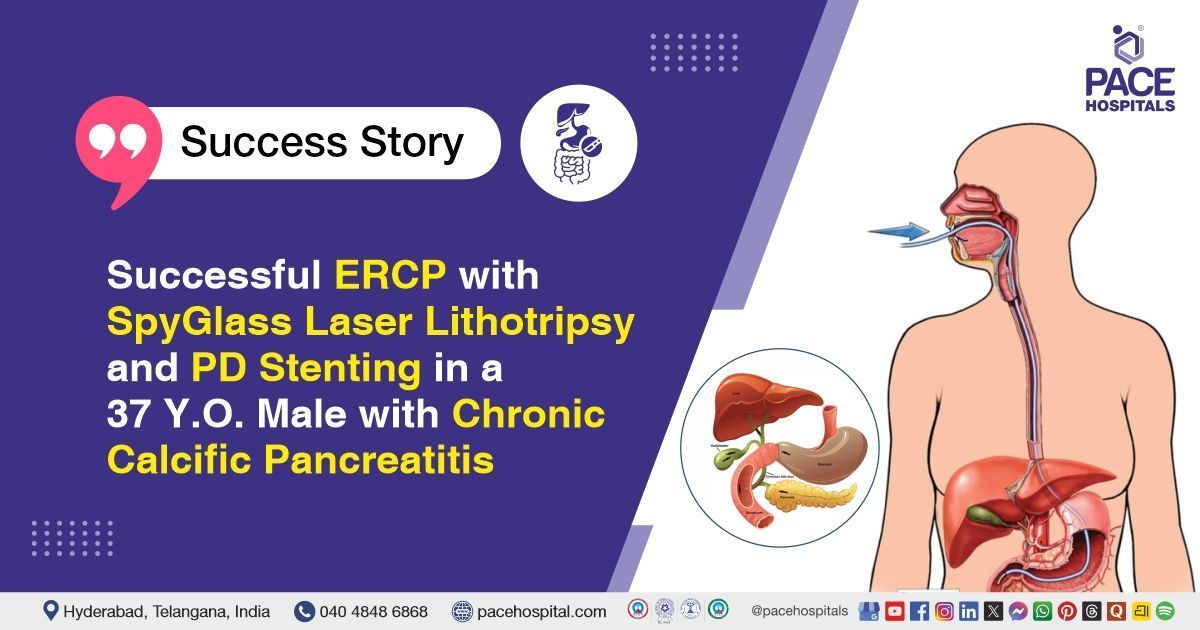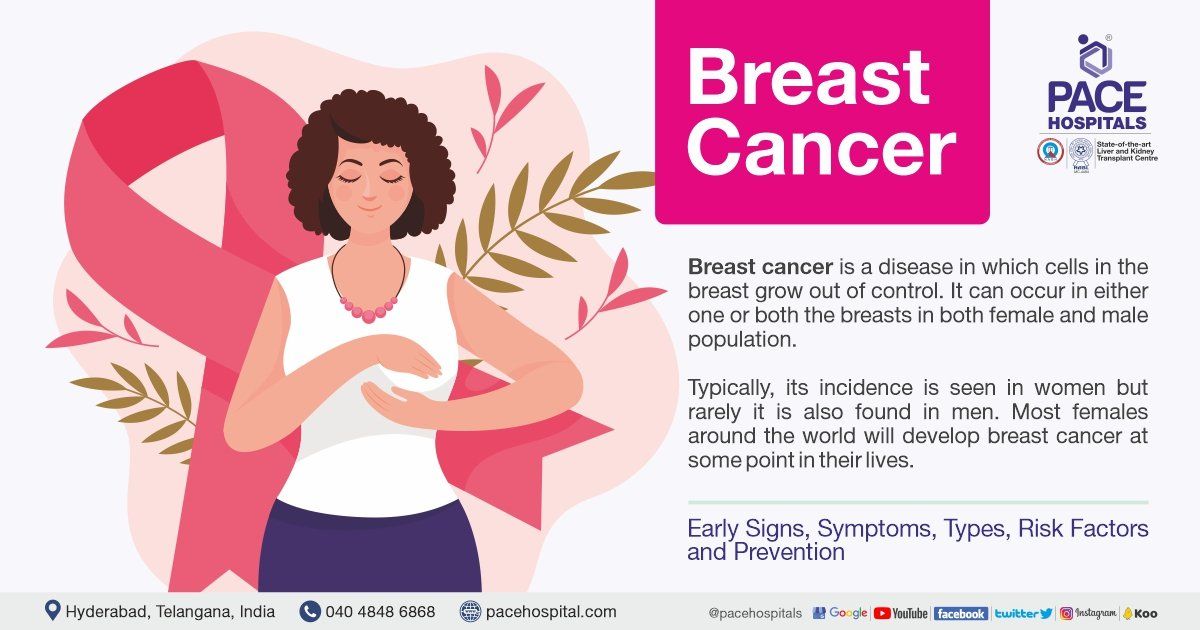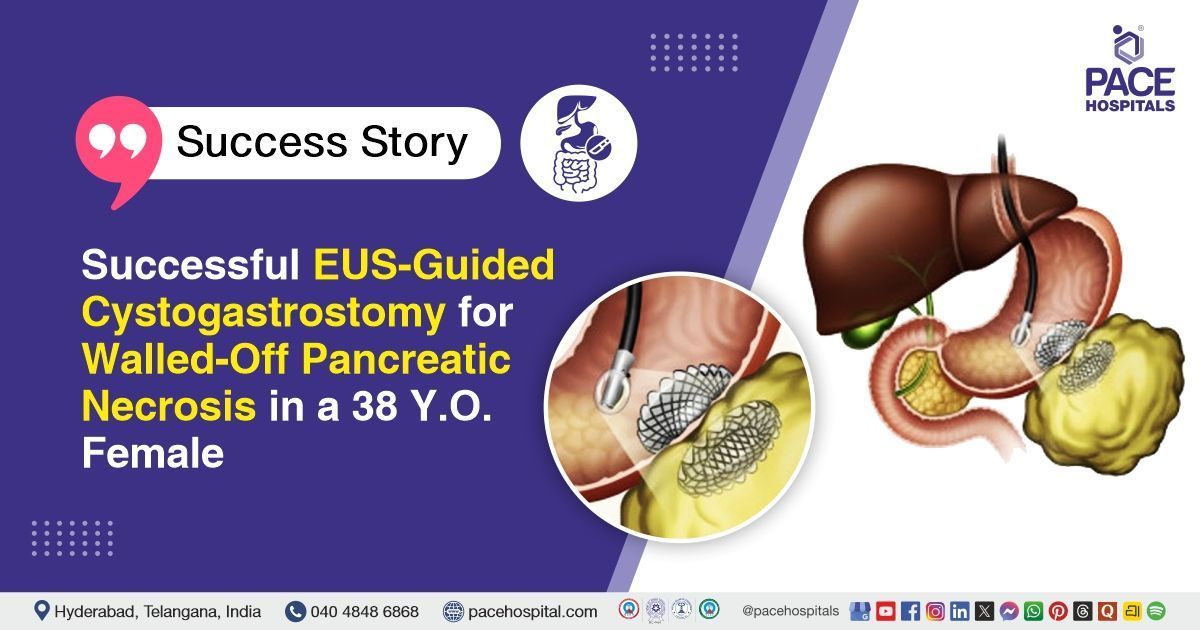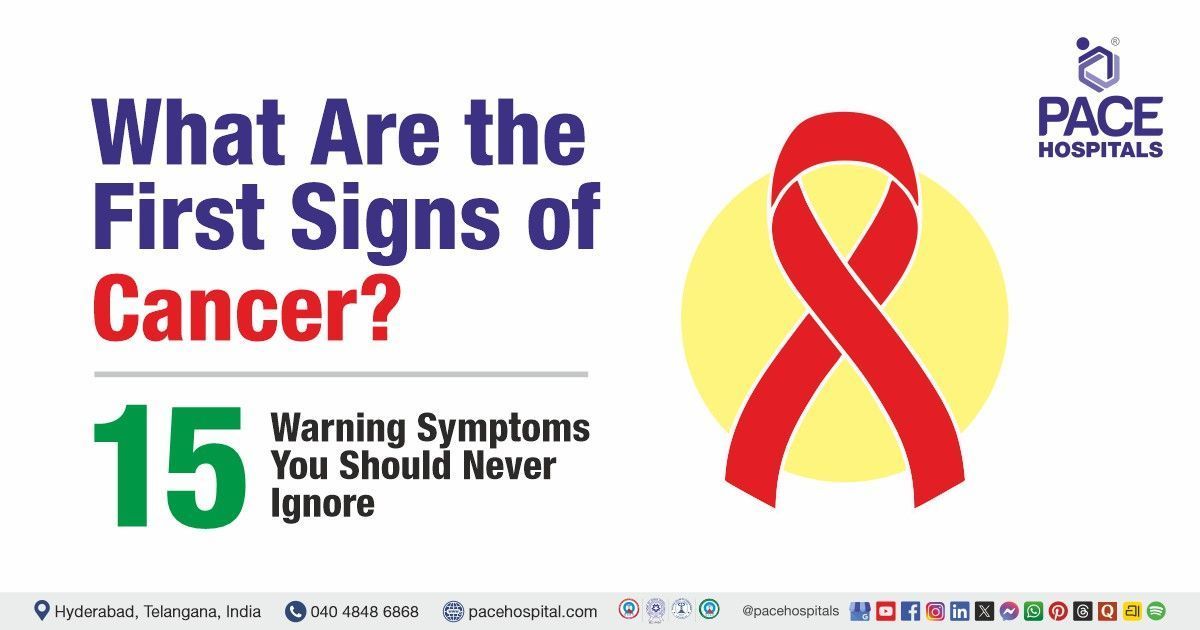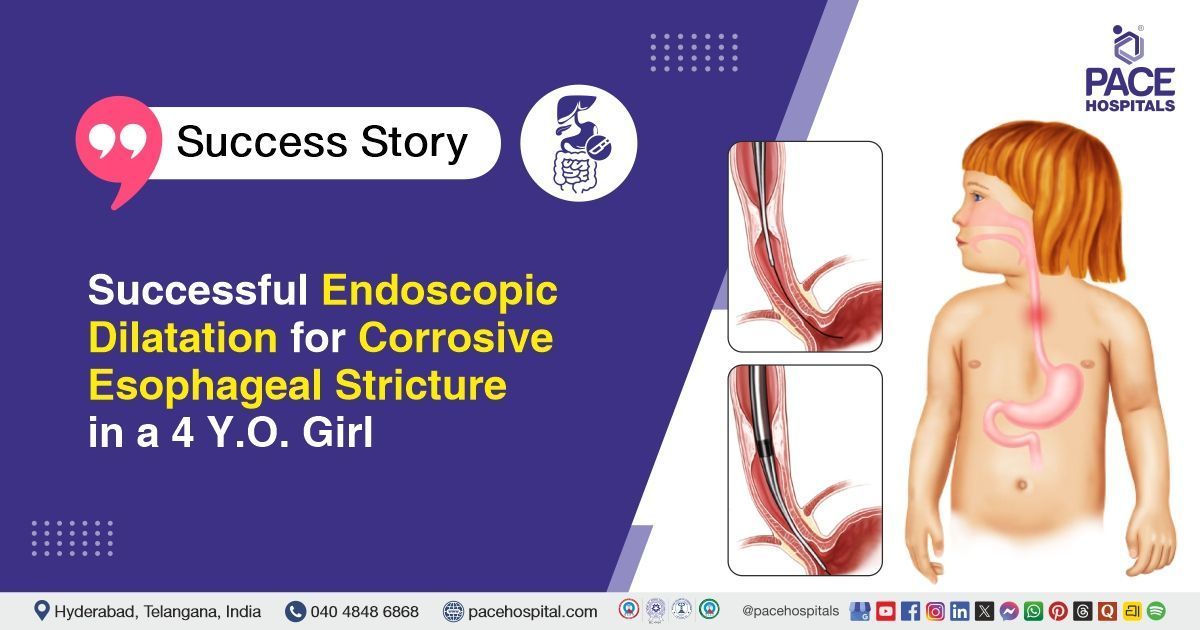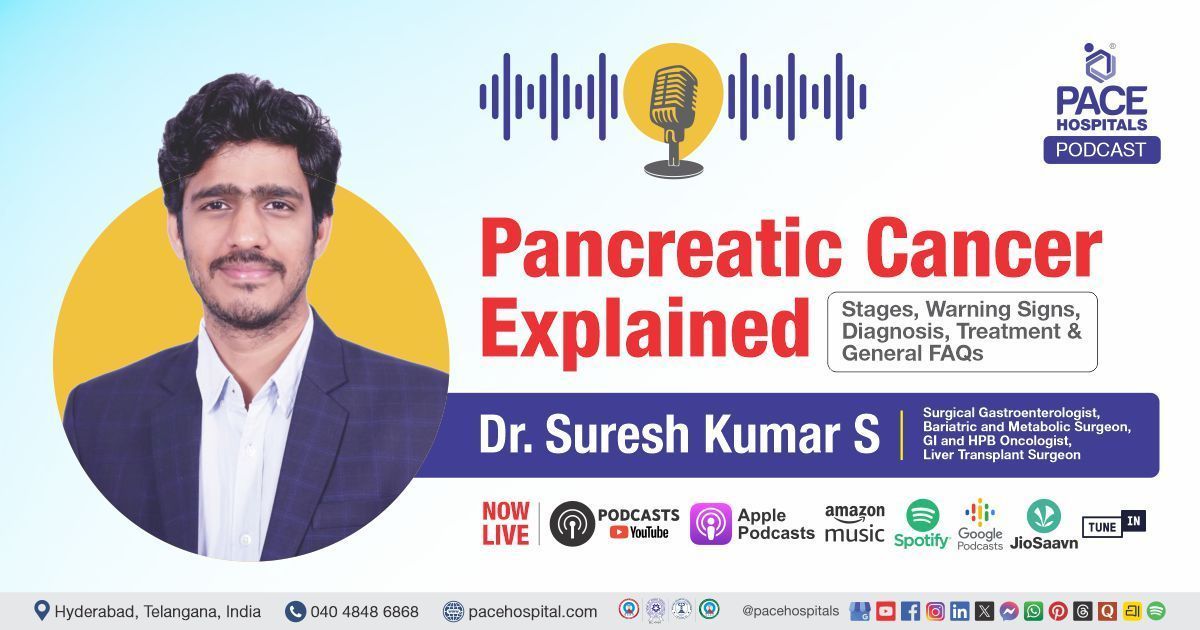Breast Cancer - Early Signs, Symptoms, Types, Risk Factors and Prevention
PACE Hospitals
Written by: Editorial Team
Medically reviewed by: Dr. Ramesh Parimi, Senior Consultant – Surgical Oncology, Specialist in Cancer Surgery
Overview | Types | Causes | Early Signs and Symptoms | Risk Factors | Diagnosis | Treatment | Prevention | When to consult a Doctor
What is Breast Cancer?
Breast cancer is a disease in which cells in the breast grow out of control. It can occur in either one or both the breasts in both female and male population.
Typically, its incidence is seen in women but rarely it is also found in men. Most females around the world will develop breast cancer at some point in their lives.
With an expected 2.3 million new cases in 2020 (11.7% of all cancer cases), it is the leading cause of global cancer incidence. Between 1965 and 1985 there was a nearly 50% increase of breast cancer incidence in India.
Types of Breast Cancer
Cancer of the breast can begin in the lobules (gland that makes milk), the ducts (the tubes which transfers milk), or even the connective tissue between these two locations. The intrinsic or molecular subtypes of breast cancer in men and women are as follows, and these subtypes include invasive, non-invasive, and metastatic (cancer spread) forms of the disease.
Most common type of breast cancer
- Ductal Carcinoma in Situ (DCIS)
- Invasive breast cancer (ILS / IDC)
Less common type of breast cancer
- Triple-negative breast cancer
- Recurrent breast cancer
- Metastatic breast cancer
Rare type of breast cancer
- Lobular Carcinoma in Situ (LCIS)
- Inflammatory breast cancer
- Paget's disease of the nipple
- Phyllodes tumours
- Angiosarcoma of the Breast
- Male breast cancer
Most common type of breast cancer
Ductal Carcinoma in Situ (DCIS) - cancerous cells forming inside a milk duct in a breast. Ductal Carcinoma in Situ is the earliest stage of breast cancer. This earliest form of breast cancer is non-invasive (does not spread out of the milk duct) with a low risk of becoming invasive. DCIS now accounts for about 20–25% of all newly diagnosed breast cancers.
Invasive breast cancer - The cancer has invaded (or infiltrated) neighbouring tissues, a diagnosis known as invasive breast cancer. Invasive ductal carcinoma (IDC) and invasive lobular carcinoma (ILC) are the most typical subtypes. About 70-80% of all breast cancers are invasive ductal carcinoma. The other types of Invasive Ductal Carcinoma can include –
- Medullary Carcinoma of the Breast
- Tubular Carcinoma of the Breast
- Papillary Carcinoma of the Breast
- Mucinous Carcinoma of the Breast
- Cribriform Carcinoma of the Breast
Less common type of breast cancer
Triple-negative breast cancer - It is a particularly dangerous form of invasive breast cancer in which the cancer cells do not produce any or too much of protein (HER2), and neither oestrogen nor progesterone receptors are present (all three tests come back negative for the cells). About 15% of all breast cancers are HER2-positive, and Triple-negative breast cancer can be a challenging cancer to treat.
Recurrent breast cancer - The breast cancer re-emerges after being treated previously. The goal of the initial treatment is to kill off all cancer cells, but some may survive. When these breast cancer cells go undetected, they proliferate (increase in numbers) and cause the disease to return. It is possible for breast cancer to return months or even years after initial treatment has ended. About 7-11% of women with early breast cancer develop local recurrence most frequently within the first five years following treatment.
Metastatic breast cancer -
Cancer that has spread from the breast to other parts of the body is called metastatic breast cancer. The signs and symptoms of metastatic breast cancer vary depending on which organs the cancer cells have spread to. Approximately 7% of women present with distant metastasis at diagnosis.
Rare type of breast cancer
Lobular Carcinoma in Situ (LCIS) - Although this is not a cancer per se, a higher risk of developing breast cancer follows a diagnosis of LCIS. This rare breast cancer variant begins in the breast lobules.
Inflammatory breast cancer - It is a particularly dangerous form of invasive breast cancer, inflammatory breast cancer causes the breast to appear "inflamed" when cancer cells block lymph vessels in the skin. It only makes up about 1-5% of all breast cancers and is extremely uncommon.
Paget's disease of the nipple - About 1-3% of all breast cancers are caused by Paget disease. The disease begins in the ducts of the breast and progresses to the nipple and then the areola (the dark circle around the nipple).
Phyllodes tumours - These rare tumours of the breast develop in the breast's connective (stromal) tissue rather than the milk-producing ducts and glands (which is where most breast cancers start). Phyllodes tumours are most common in women in their 40s. Although some phyllodes tumours can be malignant, the vast majority are non-cancerous.
Angiosarcoma of the Breast - It is a rare breast cancer (due to previous radiation therapy to the breast) that begins in the lining cells of blood vessels or lymph vessels. Usually, this type of cancer occurs eight to ten years after breast radiation therapy.
Male breast cancer - Cancer of the male breast is extremely uncommon. It is primarily seen in older men. When detected early, male breast cancer in men has a high cure rate.
Causes of Breast Cancer
Each case of breast cancer usually has an unknown origin. On the other hand, many of the potential causes of these malignancies are already well understood. Hormones appear to contribute to many instances of breast cancer, though the precise mechanisms by which this occurs is not well understood.
Mutations or changes in genes can cause normal breast cells to develop into cancer. However, there is only a 10% familial link between breast cancer and known abnormal genes (inherited).
Women with a strong family history of breast cancer may have inherited a mutation in a gene that is not yet detectable by genetic testing. Around 90% of breast cancers result from acquired (rather than inherited) gene changes.

Early Signs and Symptoms of Breast Cancer
The most common early signs and symptoms of breast cancer that usually a female may notice is a painless nodes or lumps in her breast, potentially indicating a tumor.
But at the time of diagnosis, most women don’t notice any signs of breast cancer. Generally, it’s observed early signs are discovered on an imaging test when the tumor is small in the early stages of breast cancer, it’s rarely noticeable to the naked eye or the touch.
Breast cancer signs or symptoms varies from person to person. Some people do not have any symptoms. These are some common signs and symptoms of breast cancer that need to be considered on priority:
- Breast swelling or thickening
- General pain in any area of the breast / nipple area
- Redness or skin changes in one or both breast / nipple area
- Discharge from nipple other than breast milk, including blood
- Any change in the shape, size or color of the breast
- New nodes and lumps felt inside / on the breast or underarm (armpit)
- Flaking or peeling of the nipple skin or the breast
- Irritation or itching on one or both breast
- Nipple that turns inward
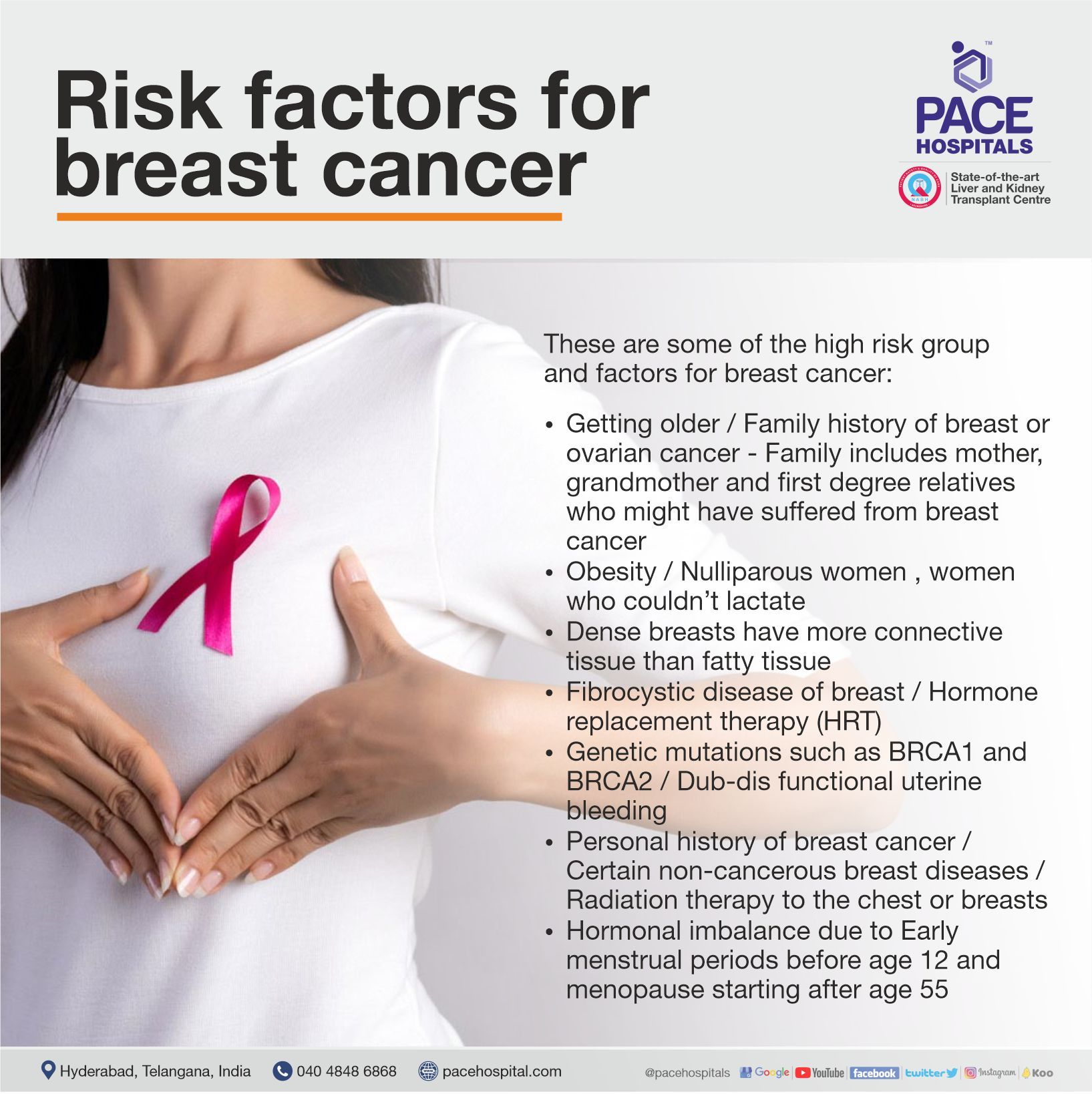
Risk Factors for Breast Cancer
As per the recent data, combination of risk factors can cause breast cancer. The main risk factors are being a woman and becoming older. Breast cancers are found mostly in women who are 50 years old or older.
Every woman has this doubt and dilemma if she is going to suffer from breast cancer. Some women will get breast cancer without having any risk factors, and some women do not get breast cancer in spite of having risk factors. Women those are having any risk factors should talk to your doctor about the risk and get yourself screened.
These are some high-risk group and factors for breast cancer:
- Getting older
- Family history of breast or ovarian cancer - Family includes mother, grandmother and first degree relatives who might have suffered from breast cancer
- Obesity
- Nulliparous women, women who couldn’t lactate
- Dense breasts have more connective tissue than fatty tissue
- Fibrocystic disease of breast
- Hormone replacement therapy (HRT)
- Genetic mutations such as BRCA1 and BRCA2
- Dub--dis functional uterine bleeding
- Personal history of breast cancer
- Radiation therapy to the chest or breasts
- Certain non-cancerous breast diseases
- Hormonal imbalance due to early menstrual periods before age 12 and menopause starting after age 55
Women who have any risk factors should discuss them with their doctor and undergo screening.
Diagnosis of Breast Cancer
Breast cancer can be detected by various type of diagnostic procedures such as:
- Physical exam
- Optical imaging tests
- Mammogram, Contrast-enhanced mammography
- Breast ultrasound, Elastography
- Biopsy - Fine needle aspiration cytology, Core needle biopsy, Punch biopsy, Vacuum assisted biopsy, Wire guided excision biopsy, Excision biopsy
- Breast MRI, Abbreviated breast MRI (fast breast MRI)
- Nuclear medicine tests (radionuclide imaging) - Molecular breast imaging, Positron emission tomography, Positron emission mammography, Electrical impedance tomography
Treatment of Breast Cancer
The treatment of breast cancer includes multiple modalities and is determined based on the stage of disease and used in many different combinations based on a patient’s specific disease. The breast cancer treatment includes:
- Breast Cancer Surgery: Surgery no doubt is the first line of treatment modality in breast cancer and performed based on the location of tumour that includes Skin-sparing mastectomy, Nipple-sparing mastectomy, Simple mastectomy, Modified radical mastectomy, Radical mastectomy, Breast-conserving surgery (BCS) or lumpectomy, partial mastectomy
- Chemotherapy: Distinctive medicines utilised for shrinking/terminating malignant cells.
- Hormonal therapy: By inhibiting the necessary hormones, cancer growth is blocked.
- Biological therapy: In conjunction with the body’s immune system, this biological therapy treats cancer or controls side effects from other cancer treatments.
- Radiation therapy: High-energy rays kill the cancer cells.
Breast cancer patients are often exposed to more than one kind of treatment. Furthermore, the treatment largely depends on the type of breast cancer diagnosed and the extent of spread.
Breast Cancer Treatment – Options and Guidelines
Surgery no doubt is the first line of treatment modality in breast cancer; rather it is the main treatment and chemo therapy and / or along with surgery is an additional (adjuvant) line of treatment for better control of the disease or better cure rates in a given situation.
And when surgery is proposed now a day’s choice is given to the patient if she would like to have -
- Mastectomy (Breast Removal Surgery) - whole breast removed surgically
- Lumpectomy (Breast Conservative Surgery) - a part of the affected breast or the lump is removed surgically
Though breast conservative surgery (BCS) can be done in most situations, there are certain well established and time tested criteria to be followed while doing a breast conservative surgery (BCS) operation in a lady with breast cancer.
Ideally, the size of the affected breast and the size of the cancer (tumour / lump) are to be taken into consideration. The tumour size should be not more than 4 CMS, and the size of the breast should be adequate, which would be decided by the treating doctor (the surgeon). The size of the breast in relation to the size of the tumour is important, in that the remaining portion of the breast after the Lumpectomy (Breast Conservative Surgery) should be "adequate".
Cosmetically, in comparison to the unaffected breast. Scientifically a small tumour of the size of 2 to 4 CMS (called t1 or t2 stage) and the same side axilla (arm pit) is devoid of spread is the ideal situation for doing a breast conservative surgery effectively. All breast conservative surgeries should not compromise the ultimate goal to remove the cancer adequately. This is called a r0 resection in surgical oncology.
So a breast conservative surgery (BCS) is possible in a small tumour (t1 or t2 stage) provided the size of the breast is also adequate in comparison. So to put it simple, a BCS is advocated in an early stage of breast cancer. Now the other situation LABC: meaning locally advanced breast cancer, here the breast size is adequate, and the tumour may be around 5 cms, and the axilla (the arm pit) is having the disease spread - the lymph nodes in the axilla are enlarged due to local spread of the cancer from the breast. That means the disease is not only in the breast but also in the axilla (of course on the same side). Here also, i.e. in a case of LABC still "at times" a BCS operation is possibly provided a specified protocol of treatment is followed (especially if the patient, insists on BCS). This protocol calls for a neo adjuvant (additional) chemo therapy before surgery and then a BCS operation at a later stage.
We would like to stress two points at this stage of discussion:
- Weather a BCS is performed, or a total mastectomy is done on the breast the type of surgery has no bearing in general on the total outcome of the treatment and the longevity which we call in oncology long time survival or the cure. Both depend on various other factors pertaining to the pathological nature of the tumour and the treatment modalities used.
- The neo adjuvant and adjuvant treatment given, which means a BCS operation in a case of breast cancer, needs chemo therapy and radiotherapy as well as part of complete treatment for the cancer.
Breast conservative surgery (BCS) / Lumpectomy is only a part of treatment in a given case. The other rare situation is a recurrence in the affected breast following a BCS after few months or years during follow up -- this situation calls for a second surgery of complete breast removal (a mastectomy). Such “local recurrence” is quite rare (around less than 2% of cases following a BCS).
A breast reconstruction, cosmetic plastic surgery is an option following a mastectomy.
Why Choose PACE Hospitals?
Expert Super Specialist Doctors
Advanced Diagnostics & Treatment
Affordable & Transparent Care
24x7 Emergency & ICU Support
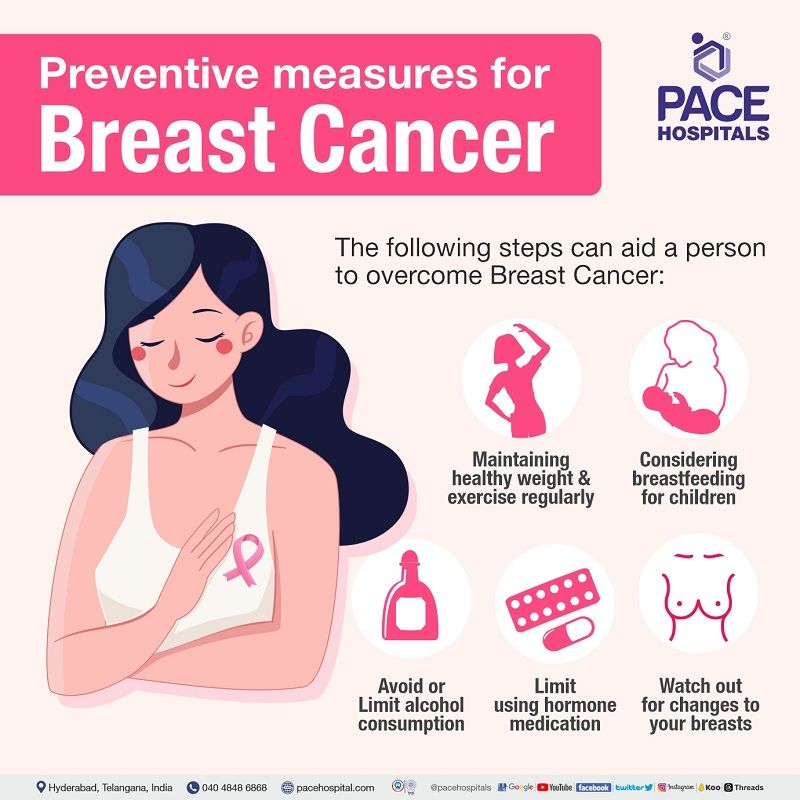
How to Prevent Breast Cancer?
There have been significant breakthroughs in the study of breast cancer. In recent years, there has been a decline in breast cancer deaths. Unfortunately, among women aged 20-59, breast cancer remains the most common cancer-related cause of death. Screening, chemotherapy, and biological prevention are just a few of today's more direct and effective approaches to breast cancer prevention.
Screening
- Over 90% of the cancer deaths are caused by metastasis from secondary tumours more often than from primary tumours.
- If breast cancer is diagnosed early stage as a primary tumour or as an early metastasis, the breast tumour can be surgically removed and the chemotherapy can be effective. Finding breast cancer in its earliest stages is the best way to prevent it.
- The usage of low-energy X-rays in mammography to capture clear images of the breast deems it to be a reliable screening method.
- MRI is not only more sensitive than mammography in high-risk women but also widely used as a screening tool for breast cancer.
Chemoprevention
- Chemotherapy constitutes the use of pharmacologic or natural agents inhibiting the development of invasive breast cancer either by blocking the DNA damage that initiates carcinogenesis (cancer development), or by arresting or reversing the progression of premalignant cells in which such damage has already occurred.”
- Chemoprevention is the process of using certain drugs or other substances to help lower a person's risk of developing cancer or keep it from coming back.
- Around 13 chemopreventive agents can be administered for treating precancerous lesions or risk reduction of invasive cancer.
Biological prevention
- Biological prevention, mainly known as the monoclonal antibodies for the breast cancer, has been developed to improve the quality of life in breast cancer patients. One of the major targets of these monoclonal antibodies is HER2.
- Reducing risk factors and taking chemoprevention are two main measures to prevent breast cancer.
Frequently Asked Questions (FAQs) on Breast Cancer
Can breast cancer be cured?
While there is no definite cure for cancer yet and it would be even difficult to treat once the patient went into the metastasis stage, the treatment rates of cancer vary greatly depending upon early diagnosis, the type of cancer, the type of treatment opted etc. Nearly all women with ductal carcinoma in situ can be cured.
What age can you get breast cancer?
Statistically, women over the age of 50 have the highest rates of breast cancer. For some women, breast cancer occurs for no apparent reason. However, a mere presence of a risk factor doesn't deem the development of the disease, and not all risk factors are equal in their impact.
Is breast cancer hereditary?
Most breast cancers occur due to the combination of genetic and environmental factors, but an estimated 5-10% of breast cancers are “hereditary,” meaning mutations in a specific gene. About 50% of hereditary breast cancers are believed to be due to the hereditary breast and ovarian cancer syndrome (HBOC).
How to check for breast cancer?
The checking for breast cancer can be done at home by a breast self-examination when its symptoms are noticeable.
A breast cancer diagnosis is done by a combination of various tests which can include biomarker tests, optical imaging tests, mammogram, contrast-enhanced mammography, breast ultrasound, elastography, biopsy, breast MRI, and nuclear medicine tests (radionuclide imaging).
What stage of breast cancer requires a mastectomy?
Stage II cancers are treated with either breast-conserving surgery (BCS; sometimes called lumpectomy or partial mastectomy) or mastectomy. A sentinel lymph node biopsy or axillary lymph node dissection may be performed to examine the regional lymph nodes.
Radiation therapy is used as a secondary treatment option for women with breast-conserving surgery following surgery. When cancer has spread to the lymph nodes, radiation is often used to treat women who have undergone a mastectomy.
What does breast cancer feel like?
The physical feeling of breast cancer can vary depending upon the type of breast cancer contracted. A few of the common and early appearances of breast cancer can include:
- thickening of the breast lump
- alteration in size, shape or appearance of a breast;
- dimpling, redness, pitting or other alteration in the skin;
- change in nipple appearance or alteration in the skin surrounding the nipple (areola)
How common is breast cancer?
With an expected 23 lakhs new cases in 2020 (11.7% of all cancer cases), it is the leading cause of global cancer incidence. Between 1965 and 1985 there was a nearly 50% increase in the incidence in India.
Can men get breast cancer?
Men also have a risk of developing breast cancer. Although it can occur at anu age, male breast cancer is mostly found in those aged 60 to 70 years of age. Male breast cancer accounts less than 1% of the overall disease.
Does breast cancer hurt?
Breast cancer mostly seen as a painless lump or thickening in the breast. It is necessary consult a health practitioner within 1-2 months even devoid of pain. Ulceration (open sores), which can be caused by advanced cancers could be painful but is often ignored.
Can a breast biopsy cause cancer to spread?
Although biopsies can spread cancer, the chances are very low. Surgeons take many steps to prevent cancer cells from spreading during a biopsy, including using special methods and different surgical tools for each area of the body. For example, a coaxial or introducer needle can be used to reduce tissue trauma and the risk of needle tract seeding.
What color is breast cancer discharge?
Either clear or blood-stained discharge from the nipple can be seen due to breast disease. It is combined with other symptoms, such as a lump or a newly inverted nipple. Physiological discharge (discharge of fluid from a normal breast) is typically yellow, milky, or green in appearance and is non-spontaneous.
Milky nipple discharge is physiological during breastfeeding and pregnancy.
Does itchy breast mean cancer?
No. Itching is a very rare symptom among most types of breast cancer. Paget's Disease could be associated with an itchy breast. Eczema, mastitis and other such conditions can cause itchy breasts.
What type breast cancer has the highest recurrence rate?
HER2-positive cancer cells are more likely to spread and come back. Also, the recurrence rate is high for triple-negative cancers. Local recurrence occurs in 7-11% of women with early breast cancer within the first 5 years after treatment.
What percentage of breast biopsies are cancer?
Breast biopsies are performed on over a million women annually, but only about 20% of them show abnormal features while the remaining 80% of women have negative biopsies for cancer.
Can you die from breast cancer?
Yes, people can die from breast cancer. Breast cancer is the most common cancer worldwide, not just in India. According to the International Agency for Research on Cancer, one in four female cancer patients worldwide were diagnosed with breast cancer in 2020 while 37.2% of Indian female deaths were from breast cancer. India had a higher mortality rate than the rest of Asia, which was 34%. The global average was 30%.
When to consult a doctor for breast cancer?
Consult a doctor for breast cancer if you notice any unusual or persistent breast changes. Signs that need medical attention include:
- A new lump or thickening in the breast or underarm
- Changes in breast size or shape
- Skin dimpling, puckering, or redness
- Nipple discharge, especially if bloody
- Persistent pain, tenderness, or swelling
If your symptoms do not go away or worsen, consult a breast cancer doctor for proper evaluation and treatment. Early consultation helps detect cancer when it is easier to treat and manage. A breast cancer doctor may be a gynaecologist, breast surgeon, or oncologist who specialises in breast care. Seek immediate medical assistance if you notice any sudden breast changes, severe pain, or signs of infection such as redness or fever.
Share on
Request an appointment
Fill in the appointment form or call us instantly to book a confirmed appointment with our super specialist at 04048486868
Appointment request - health articles
Recent Articles
